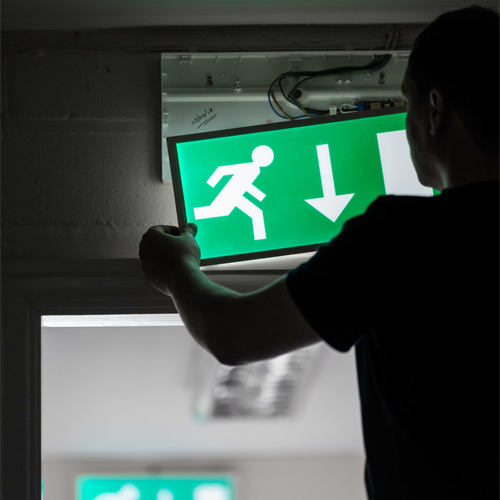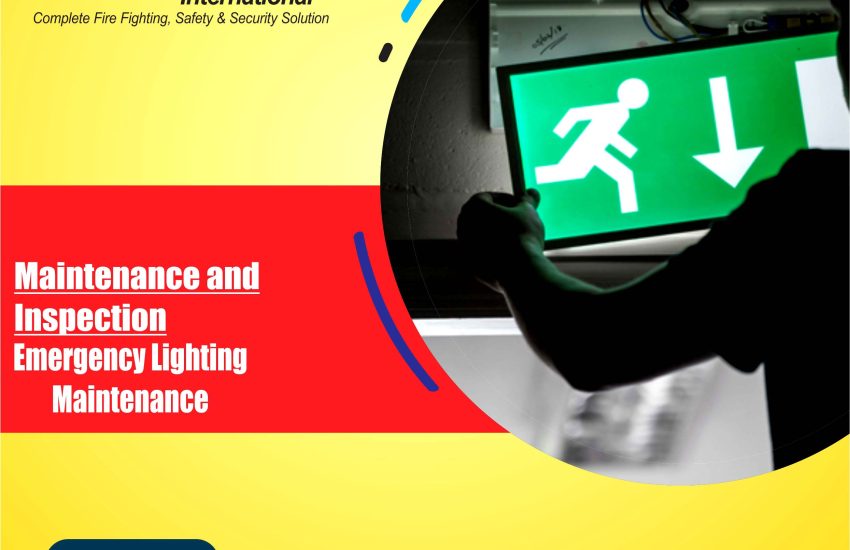Emergency lighting is an essential safety feature for any building. It ensures that occupants can safely exit during a power outage or emergency situation. Regular emergency lighting maintenance is crucial for ensuring these systems function correctly when they are most needed. This article discusses the importance of emergency lighting maintenance, the maintenance process, and why keeping your system in optimal condition is vital for both safety and compliance.
What is Emergency Lighting Maintenance?

Emergency lighting maintenance involves regularly inspecting, testing, and servicing emergency lighting systems. This process ensures that components such as exit signs, emergency lights, and other safety lighting remain functional during a power failure or emergency. Regular maintenance helps prevent failures by identifying issues such as worn-out batteries, faulty wiring, or damaged fixtures before they affect system performance.
Key tasks in emergency lighting maintenance include:
- Exit Signs: Ensuring exit signs are clearly visible and illuminated.
- Emergency Light Fixtures: Verifying emergency lights are in good working condition.
- Battery and Power Supply: Testing the backup power source for full charge.
- Wiring and Connections: Inspecting for damage or degradation.
- System Tests: Conducting routine tests to confirm compliance with safety regulations.
Why is Emergency Lighting Maintenance Important?
Emergency lighting is a vital part of your building’s safety infrastructure. Below are some key reasons why you should prioritize emergency lighting maintenance:
1. Ensuring Safety During Power Outages
In the event of a power failure, emergency lighting systems provide essential illumination. These lights allow people to find exits and evacuate safely, reducing the risk of accidents or panic. Regular maintenance ensures that your system works when it’s needed most.
2. Compliance with Fire Safety Regulations
Emergency lighting systems must comply with various safety standards, such as those set by the National Fire Protection Association (NFPA) and local building codes. These regulations mandate that emergency lighting be regularly tested and inspected to meet safety and performance standards. Failure to maintain your system could result in legal consequences, including penalties.
3. Preventing System Failures
Over time, the components of emergency lighting systems can degrade. Batteries can lose charge, wiring can become damaged, and light fixtures can fail. Routine maintenance helps identify these issues before they cause a system failure, ensuring the system works reliably in an emergency.
4. Protecting Property and Assets
In addition to safeguarding lives, emergency lighting helps protect property. These lights guide people to exits and prevent confusion, reducing the likelihood of property damage. A well-maintained emergency lighting system minimizes risks and ensures a quicker, safer evacuation.
What Does Emergency Lighting Maintenance Involve?
Emergency lighting maintenance consists of several important tasks. Each of these tasks ensures that the system works as intended, providing the necessary illumination in an emergency. Here’s an overview of the key maintenance steps:
1. Visual Inspection of Emergency Lights
Technicians begin by visually inspecting all emergency light fixtures and exit signs. They ensure that the lights are bright, visible, and free from damage. Additionally, technicians check for obstructions that could block the light or impair visibility.
2. Testing the Backup Battery System
Testing the backup battery system is crucial. Technicians check whether the batteries are fully charged and able to power the lights during an emergency. If the batteries are old or no longer hold a charge, they are replaced to prevent failure during a real emergency.
3. Checking Wiring and Electrical Connections
The wiring and electrical components of the system are checked for any damage, such as frayed wires or loose connections. These inspections prevent electrical issues that could cause the emergency lights to fail. Ensuring proper wiring is essential for system reliability.
4. Testing the System’s Functionality
Technicians conduct regular system tests to ensure everything is functioning as expected. This typically includes simulating a power failure to verify that the emergency lights turn on automatically and remain on for the required duration. Testing ensures the lights provide enough illumination for safe evacuation.
5. Documentation and Compliance Checks
Routine maintenance includes keeping detailed records of inspections and repairs. Technicians document each test result and note any replacements or repairs. This documentation proves compliance with safety regulations, which is vital for legal and insurance purposes.
How Often Should Emergency Lighting Maintenance Be Performed?
The frequency of emergency lighting maintenance depends on local regulations and the type of building. However, general guidelines include:
1. Annual Inspections
A complete inspection should be performed at least once a year. This annual check includes testing the entire system, verifying the operation of lights, and checking the battery backup. Certified technicians should conduct this thorough inspection.
2. Monthly Self-Testing
In addition to the annual inspection, monthly self-tests should be conducted. This involves checking the basic functionality of the emergency lights, including ensuring the bulbs are working and the lights illuminate properly. This self-test helps identify issues early.
3. After System Modifications
When the building undergoes any modifications, such as renovations or electrical updates, the emergency lighting system should be re-inspected. Changes to the layout or electrical systems may affect the operation of emergency lights, so it’s essential to ensure the system functions correctly in the new environment.
4. After Power Failures or Malfunctions
If the emergency lighting system experiences a malfunction or is activated during a power failure, it should be inspected afterward. Technicians will test the system to ensure it’s operating properly and address any issues caused by the malfunction.
Benefits of Professional Emergency Lighting Maintenance Services
Hiring a professional service provider for emergency lighting maintenance offers several advantages:
1. Expertise and Precision
Certified technicians have the expertise to perform thorough inspections and identify issues that might be overlooked. Their skills ensure that all components are tested correctly and any problems are addressed promptly.
2. Compliance Assurance
Professional maintenance services help you stay compliant with local building codes and fire safety regulations. Technicians are familiar with the latest standards, ensuring your system meets legal requirements.
3. Proactive Issue Resolution
Professionals identify potential issues before they become significant problems. They perform proactive maintenance, which reduces the likelihood of system failure during an emergency.
4. Peace of Mind
By relying on professionals, you can rest easy knowing your emergency lighting system is well-maintained. Professional maintenance gives you the confidence that your system will work when needed most, keeping everyone safe.
Conclusion: Prioritize Emergency Lighting Maintenance for Building Safety
Emergency Lighting Maintenance is a critical component of building safety. Regular inspections, battery tests, and system checks ensure that emergency lighting systems operate effectively, protecting the lives of occupants during emergencies. By investing in ongoing maintenance, you ensure that your building remains safe, compliant with regulations, and fully prepared for power outages or other emergencies.


